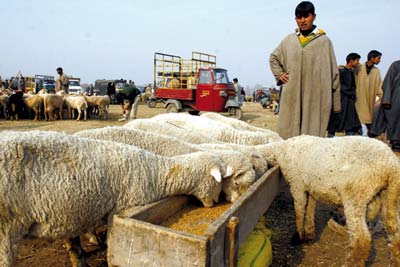define the end rate for mutton, “We have been allotted a profit of Rs 30 per kg, and if a wholesale dealer sells us mutton at Rs 268 a kg, we will sell it at Rs 298.”
But when the dealers supply us mutton at Rs 320 per kg, Regoo says, how is it possible for us to sell it at Rs 298 per kg fixed by the CAPD.
Regoo, who is a retailer himself, says they have been made scapegoats. He feels there are two ways to resolve the matter. “Opening of fair price shops by CAPD will be one such step to regulate prices. The other step could be decontrolling the prices, which will force retailers to finish their products before day ends, even at reduced prices.”
While government has set rates for Srinagar based mutton retailers, Regoo claims, in the other parts of the valley, retailers sell mutton at their own set rates.
Muttonomics!
Harboring a whopping 85 per cent non-vegetarian population, the valley consumes 253.9 lakh kg of mutton per annum, excluding beef. To have their ‘pound of flesh’, Kashmiris spend Rs 761 crore a year on mutton alone.
While 144.1 lakh kg of mutton is imported from outside Mandis (Markets) annually, mainly from Rajasthan, Delhi and Amritsar, the net local produce of mutton is 109.8 lakh kg per year.
The statistics further reveal Kashmir consumes around 5500 sheep/goats a day, which makes it around 75 thousand kg of meat daily.
During marriage season the demand for mutton increases considerably as traditional feasts are entirely non-vegetarian. Taking the mutton consumption during marriages into consideration, the official figures suggest mutton and its allied sector has already crossed Rs 1000 crore mark.
Mutton Mafia!
Many believe middlemen, in connivance with the officials are actually behind the present crisis.
Mehraj ud Din Ganai, president Kashmir Wholesale Mutton Dealers Association, claims that association contributes less than 10 per cent to the retail market, rest comes through illegal dealers.
“It is the middlemen who import livestock,” Ganai says. “Kothdars (traditional mutton dealers) have become irrelevant over the years as commissioning agents took over the business. They (mafia) are the people who hike mutton prices in the valley.”
The government had failed to check the illegal supply of mutton, as per Ganai. “Even the authorities are not able to enforce uniform rates in the market,” he says.
Ganai claims ‘mafia’ is making people dependent on imports from other states. Kashmir relies on outside states for 56 per cent of its mutton supply. “We have stopped importing animals from April 18, but still livestock is being supplied to Kashmir by agents who actually are responsible for this crisis,” he said.
Meanwhile, around 26,000 sheep are imported to Srinagar from outside the state on weekly basis for supply of mutton to the consumers during present mutton crisis.
Retailers allege that CAPD has issued licenses to dealers who are in fact part of the illegally supply chain.
“If the government is really serious to control mutton rates they have to catch the big fish instead of chasing small ones. We appreciate the crackdown because this has infused a kind of hope that the prices will be controlled,” Ganaie said. “But authorities should stop harassing shopkeepers as it will not bear the desired results.”
Officials’ Take
 Mushtaq Ahmad Mir, director CAPD department, says both retailers and wholesale dealers want prices to increase, but the department will not allow this to happen.
Mushtaq Ahmad Mir, director CAPD department, says both retailers and wholesale dealers want prices to increase, but the department will not allow this to happen.
Mir acknowledges there are certain commission agents who are acting as dealers and brokers and these enforce their own rates.















